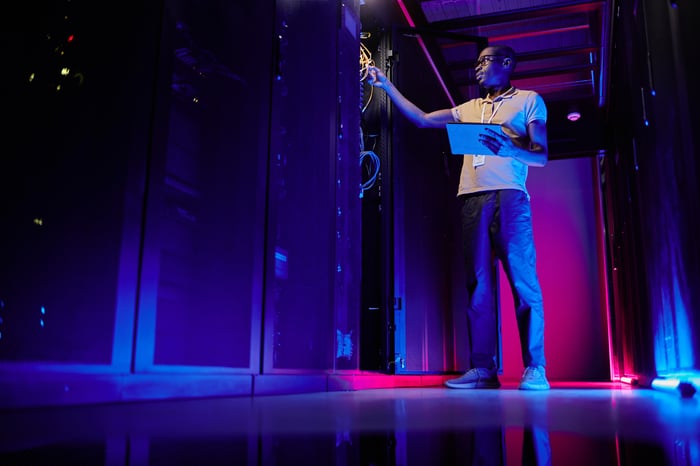The speed with which artificial intelligence (AI) caught on last year took many investors by surprise, and it sparked a changing of the guard among the ranks of the world's most valuable companies. Apple was finally dethroned by Microsoft, which now tops the list as the only company that currently has a market cap of more than $3 trillion. Nvidia, fueled by its industry-leading AI processors, has tripled over the past year to take the No. 3 spot, behind Apple with $2.6 trillion. Alphabet, Amazon, and Meta Platforms are all major players in the AI revolution and also members of this auspicious fraternity.
With a market cap of just $53 billion (as of this writing), it might seem like hyperbole to suggest that Super Micro Computer (SMCI -0.03%), also called Supermicro, could make a run at the $1 trillion club. However, the accelerating demand for AI-centric servers and the company's decades of expertise suggest that Supermicro is a dark horse candidate in the race.

Image source: Getty Images.
Servers of the stars
While Supermicro has been creating customized server solutions for more than 30 years, the company was working in relative obscurity until the accelerating adoption of AI kicked off. It turns out that Supermicro has amassed quite a pedigree out of the glare of the spotlight.
Supermicro has built its reputation by providing highly customizable, energy-efficient, liquid-cooled rack-scale servers designed to handle the rigors of AI and hyperscale data centers. The company has developed strong working relationships and works hand-in-hand with all the top AI chipmakers to ensure its rack-scale servers are top performers while also providing energy efficiency and the lowest total cost of ownership in the industry. It boasts partnerships with Nvidia, Advanced Micro Devices, and Intel, among others.
This is a winning strategy that has its AI-centric servers flying off the shelves. For its fiscal 2024 second quarter (ended Dec. 31), Supermicro's revenue surged 103% year over year to $3.7 billion, while its earnings per share (EPS) of $5.10 jumped 85%. Management is forecasting its triple-digit growth will continue, raising its full-year guidance to $14.5 billion, which would represent growth of 104%.
Management reports that Supermicro grew five times faster than the industry average over the preceding 12 months, suggesting the company is stealing market share from its rivals. Analysts at Northland agree, suggesting the company has increased its market share to 11%, leaving "plenty of room for future share gains."
The path to $1 trillion
Supermicro is in an enviable position among AI server makers. The company is small enough to be nimble and has a long history of providing customized server solutions to enterprises. Furthermore, the strong and enduring relationships Supermicro has forged with chipmakers give it the inside track and an abundant supply of the processors used for AI. Despite those advantages and the clear opportunity, a lot will have to go right for Supermicro to join the ranks of the trillionaires.
According to Wall Street, Supermicro is poised to generate revenue of $14.7 billion in 2024, giving it a forward price-to-sales (P/S) ratio of roughly 3.6. Assuming its P/S remains constant, Supermicro would have to grow its revenue to about $275 billion annually to support a $1 trillion market cap. To be clear, the company is currently ramping up production to support annual sales of $25 billion, so revenue of that magnitude is still a ways off.
If the company were able to keep up its triple-digit, year-over-year growth, Supermicro could reach the $1 trillion market cap threshold by 2031. That said, it's unlikely the company will keep up its current rate of parabolic growth. If we cut its revenue growth rate assumption to 50%, Supermicro could potentially reach a $1 trillion market cap by 2035.
There's reason to believe strong demand for AI-centric servers will continue. BofA analyst Ruplu Bhattacharya suggests the data center market will grow at a compound annual growth rate (CAGR) of 50% over the next three years, and Supermicro's revenue could grow even faster.
Nvidia CEO Jensen Huang is equally bullish, suggesting that the installed base of data centers will double to $2 trillion over the coming four to five years.
If Supermicro captures even a small part of that vast opportunity, the company will soon join the $1 trillion club.





